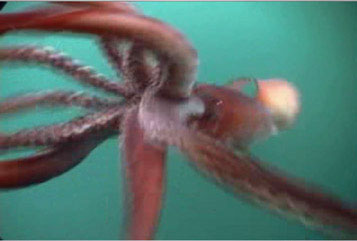Squid beaks may revolutionize engineering
Squid beaks may revolutionize engineering
Jeremy Hance, mongabay.com
March 27, 2008
Researchers uncover the secret of super-hard squid beaks. Graded beaks may revolutionize engineering
|
|
When scientists dissect the stomachs of sperm whales, they find the super-hard beaks of squids, the only part of them that is indigestible. Scientists can tell the diet of a whale by the variety of beaks left behind, sometimes numbering in the thousands. But how does a squid, whose body is soft and supple, have a beak that is considered one of the hardest organic materials in natures? Scientists have long pondered this question.
“Here you have a ‘cutting tool’ that’s extremely hard and stiff at its tip and is attached to a material — the muscular buccal mass — that has the consistency of Jell-O,” explains Frank Zok, professor and associate chair of the Department of Materials at the University of California of Santa Barbara. “You can imagine the problems you’d encounter if you attached a knife blade to a block of Jell-O and tried to use that blade for cutting. The blade would cut through the Jell-o at least as much as the targeted object”. Dr. Zok and his colleagues have recently uncovered the mystery to the squid’s beak.
 Humboldt squid. Credit: Scot Anderson |
According to researchers the key is that the hardness of the squid’s beak is graded. The tip of the squid’s beak is 100 times stiffer than its base. This softer more compliant base allows the squid to wield a knife-like beak for hunting fish without harming its own soft tissue. This gradation only survives in water; if the beak is dried out the base becomes as hard as the tip. The squid’s beak is composed of chitin, water, and protein enriched by Dopa. Dopa is a posttranslational modified protein. A recent study of Dopa by Philipp Messersmith, shows that as the beak becomes harder — towards its tip — it becomes higher in protein with Dopin and lower in chitin, which also appears in insect exoskeletons.
Scientists believe this discovery of the beak’s gradation could have practical applications for humans. “I’d always been skeptical of whether there is any real advantage to ‘functionally graded’ materials, but the squid beak turned me into a believer,” said Dr. Zok, who hopes this discovery can help to create new engineering opportunities similar to that of a squid’s beak. “If we could reproduce the property gradients that we find in squid beak, it would open new possibilities for joining materials. For example, if you graded an adhesive to make its properties match one material on one side and the other material on the other side, you could potentially form a much more robust bond.” He added: “this could really revolutionize the way engineers think about attaching materials together.”